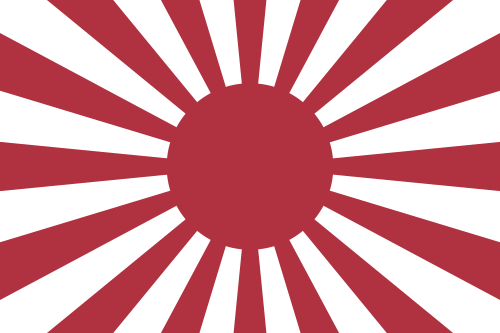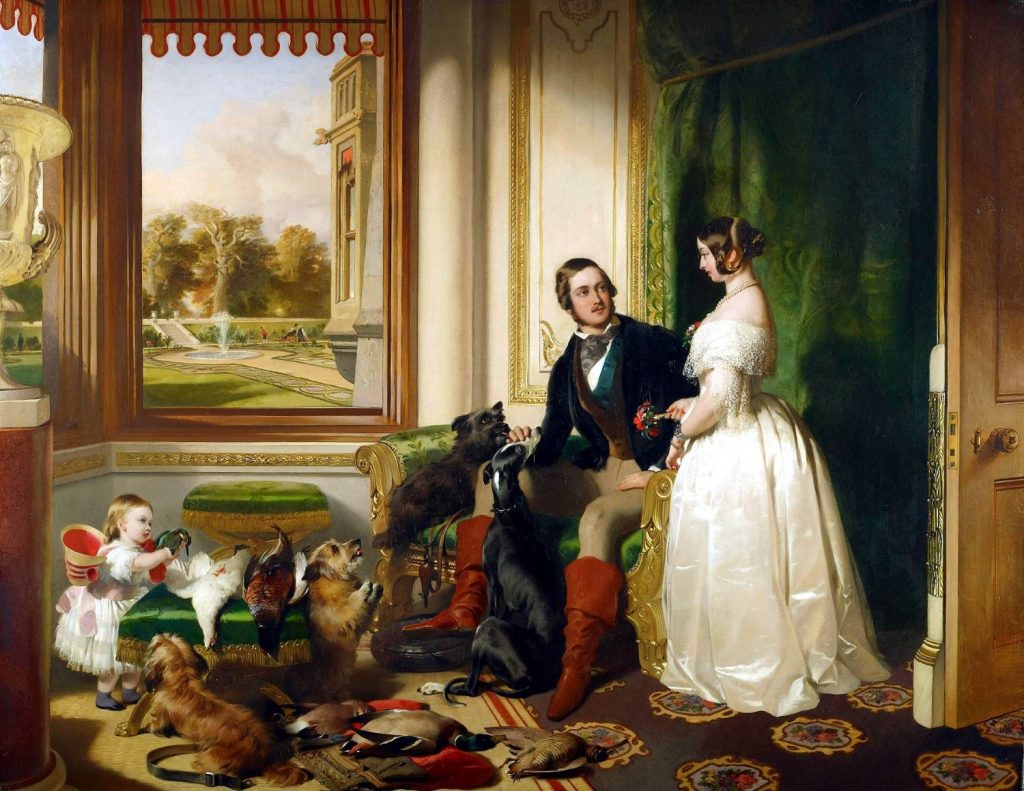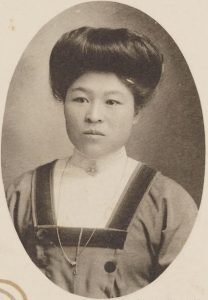By Sean Kazato Hosoi
and Rosalyn Hird
Introduction
Women and sports? Unacceptable. This was the prevailing thought that accompanied women’s physical activities in pre-war Japan.[1] In this kind of situation, it is not hard to imagine the difficulties in promoting physical education for women. What especially came in the way were ideas of femininity that were held strongly in the minds of Japanese people in pre-war Japan. Women were viewed as fragile and tender, and sports education was seen as a subject that would damage this femininity. However, there were some pioneers who took on a role in promoting women’s physical education. Some of those were genuinely inspired by foreign sports culture. On the other hand, what prompted Japan to introduce female’s participation in physical activities was the growing demand for strong and healthy females who could produce a strong population. While especially examining the ideas of femininity, this project will focus on how physical education for women was promoted in pre-war Japan and the difficulties in expanding it.
Fukoku Kyōhei and Ryōsai Kenbo
I would like to open this isolated Japan to a Western-style civilization and avoid falling behind the rest of the world by enhancing the wealth and military power of the nation (fukoku kyohei).[2]
-Fukuzawa Yukichi
As the famous Japanese educationalist Fukuzawa Yukichi in 1899 mentioned, fukoku kyōhei—which could be translated literally into “rich nation and strong country”—was a growing notion of Japan in the pre-war period. During this period, Japan won the Japanese-Russian war (1904–1905), which was the first full-scale battle, and gained tremendous power. This led to the mindset that the reason why a Japanese could beat a physically advantaged Russian was because Japanese won by spirit. Therefore, to increase overall power, physical education for both male and female gained attention as training that develops the body and mind. Although physical education gave the image of a stout woman, which conflicted with traditional beauty, the debate over exercising women for health was repeatedly emphasized. This was because the female body was considered as a means to provide a future healthy nation with higher levels of physical ability.[3]

Figure 1: Imperial Japanese Army Flag, (n.d.).
With this political ideology of fukoku kyōhei came the ideal image of women, ryōsai kenbo.[4] As the demand for a strong nation increased, the female role of producing healthy children increased as well. Thus, spreading the concept of ryōsai kenbo was practical to achieve fukoku kyōhei. Explained in detail, ryōsai kenbo prompts women to be a “good wife and wise mother.” According to Keiko Ikeda, a researcher in the history of physical education, this does not mean being a good wife or mother in one’s own household. In the context of fukoku kyōhei, this meant being a healthy and strong female who could produce strong children.[5] In other words, the female body was dedicated to the nation. However, this concept did not actually originate in Japan. It was imported from the Western countries, especially from England in the Victorian era, where the ideal image of a woman was a wife who is wholeheartedly committed to her husband and family, the “angel in the house.”[6] Japan was eager to introduce and implement this Western idea to achieve fukoku kyōhei. On this road to fukoku kyōhei, Ikeda states that an essential individual is Fujimura Toyo, a female physical educationist who had studied in Germany. Returning to Japan, she suggested the importance of training women to become well-prepared mothers. The training mainly focused on women’s physical education, for example, introducing women’s exercise for preparation of childbirth.[7] This was frequently encouraged in Japan’s female physical education, which was based on the idea of fukoku kyōhei and ryōsai kenbo.

Figure 2: Windsor Castle in Modern Times, Queen Victoria and her Family by Edwin Landseer, 1842. Wikimedia Commons.
This image reflects the concept of “Angel in the house” in which Queen Victoria wears a white angelic dress.
Pioneers of Female Physical Education in Japan
The experiences of studying abroad in Western countries greatly influenced pioneers of female physical education in Japan. While the pioneers brought back Western-style gymnastics for female physical education, they also reflected the educational training for a future wife and mother, a common concept in Western countries, especially England. For example, Tokuyo Nikaidō (1880-1941) was ordered from the Japanese Ministry of Education to study at a Physical Training College in London in 1913. After returning from England, she became a profound figure who first introduced hockey and cricket to Japan.[8] Moreover, she established Nikaidō Taisojuku Gymnastics school, a cram school for women’s physical education and a training institution for female gymnasts and female gymnastics teachers.[9] Similarly, Inokuchi Akuri (1870–1931) was sent to the United States to learn physical education at the request of the Japanese government. She learned about women’s physical education at Smith College and became a professor at Tokyo Women’s Higher Normal School. In this school, she taught the Swedish style of exercise, which was introduced as women’s gymnastics at Smith College.[10]

Figure 3: Inokuchi Akuri, 1912.
Originally her parents named her “Aguri” since they followed the myth, if you wanted a boy but a girl was born, you name the baby “Aguri” so that the next child will be a boy. However, she changed the name “Aguri” to “Akuri” since she disliked the pronunciation which was similar to the English term “ugly”.

Figure 4: Tokuyo Nikaidō, 1920.
Video 1: Swedish gymnastics that Akuri introduced.
Although not female, one of the founders of Nihon joshi daigakkō (College of Japanese Women), Jinzō Naruse (1858-1919), proposed an artistic form of gymnastics created by the French, Francois Delsarte—called the “Delsarte system”—as well as other women’s physical activities. This novel gymnastic contributed to introducing the idea of female physical education in the form of dance.[11] Additionally, another important male figure was Junjirō Hosokawa (1834-1923), who was the fourth principal of Kazoku Jogakkō. In this girls-only school, Hosokawa created undōkai in 1894 (a traditional sport event for Japanese schools) for female students, which was previously held only for male students.[12] This inclusion of women into undōkai further emphasized the importance of female physical exercises. In this way, the influence of western gymnastics and the efforts of the above pioneers took a vital role in promoting physical education for women in Japan.

Figure 5: Junjirō Hosokawa. (n.d.). Baron Hosokawa, acting chancellor of Gakushuin. Retrieved from Wikimedia.
Video 2: Francois Delsarte—called the “Delsarte system”
Obstacles in the Promotion of Women’s Physical Education
I do not care if people speak ill or make fun of female gymnastics teachers, I intend to devote my energy to doing this job[13]
-Nikaidō Tokuyo
As can be seen from this quote by Nikaidō, female physical education was not easily accepted by the general public. In other words, the idea of women engaging in sports was a matter of criticism and even more, laughter. Therefore, Japan’s pioneers of female physical education, including Nikaidō Tokuyo and Inokuchi Akuri, faced many obstacles. The difficulties in promoting physical education for women, were due to the embedded ideas of femininity, the image of women being fragile, and thus limited women’s physical activities, according to Robin Kietlinski,[14] a researcher of Japanese sports and society.

Figure 6: Female tuberculosis patient resting in a sanitarium (Nankoin), 1931. Wikimedia Commons.
Particularly in the Meiji period, femininity was associated with pale skin, a slender body and fragile looks. Hence, physical education that could result in tanned skin and stronger looks was considered inelegant and disgraceful. On the other hand, a fragile body was thought of as elegant and preferable. Interestingly, what gave rise to this preference was the spread of tuberculosis, which occurred in the Meiji period. In pre-war Japan, tuberculosis was almost an incurable and hazardous sickness. However, the breakable image that accompanied tuberculosis victims was frequently written about in literature and spread to the public. As a result, romantic ideas for women, such as “beauties die young,” came to be strongly associated with tuberculosis.[15] To this ideal image of fragile women, Inokuchi Akuri argued that “a woman was not truly beautiful unless she was healthy in body and mind.”[16]

Figure 7:日本之雨(Japanese Rain) by Yumeji Takehisa, 1932. Wikimedia Commons.
Nevertheless, as can be assumed, Inokuchi was condemned for introducing female physical education that may result in the alteration of the status quo of women, which had long been encouraging the image of “fragile beauty”.[17] For the general public, female physical education was a threat, as it prompts women to use their muscles and thereby could damage the ideal femininity.[18] Thus, although the Japanese government and pioneers promoted female physical education, women were casted out from “intensive” physical activities such as baseball.
Attire of Female Physical Education
P.E. attire is made to enhance students’ physical activity by providing comfort and flexibility. Especially in the hot and humid summers of Japan, it is essential to wear P.E. attire that exposes a good amount of skin which allows body heat to be released. Specifically, today in contemporary Japan, both female and male students share the same functional outfit, a simple combination of short pants and a short-sleeved shirt. Was it always like this? No. Especially not for women in pre-war Japan. The conventional concept of femininity (fragile and tender) even affected women’s attire for physical education. For instance, the attires presented by Inokuchi Akuri, the first P.E. uniform for women, reflects the remaining notion of femininity. Ikeda mentioned that Akuri introduced bloomers for female gymnastics attire in the Meiji era, but the clothing exposed little skin and was less flexible.[19] Specifically, this was because the prospect of women exercising with active outfits gained criticism to the general public of Japan, as people claimed that those types of attire were vulgar and, moreover, would signal the loss of femininity—elegance and chastity.[20]

Figure 8: P.E. attire during the Meiji era, from Inokuchi Akuri 井口阿くり, Taiiku no rironkyū jissai 体育之理論及実際 (Kakkōsha, 1906), pp. 403–405. National Diet Library Digital Collections.
These bloomers were introduced by Inokuchi Akuri in 1906.
Conclusion
The prevailing notion of women’s physical activities in pre-war Japan was associated with negative thoughts due to the idea of femininity that idealized women’s fragility and tenderness. Physical education was considered a factor that could damage this femininity. These embedded ideas were obstacles to the promotion of women’s physical education.
However, there were some pioneers who contributed to promoting women’s physical education. As some were genuinely influenced by foreign sports culture, the Japanese government was enthusiastic about introducing female’s participation in physical activities since there was a growing demand—especially after the Russo-Japanese War—for strong and healthy females who could produce a strong population. To achieve this national goal, substantial progress in the promotion of female physical education was made, through pioneers such as Inokuchi Akuri and Nikaidō Tokuyo.
Nevertheless, the remaining notion of femininity could also be seen in P.E. attire in pre-war Japan. While Akuri introduced the first gymnastics clothes for women in Japan, the attire exposed limited skin, although it may have led to discomfort and difficulty in moving flexibly. Overall, this seemingly simple topic—physical education for Japanese women—showed that the notion of femininity is entwined with politics, history, and even attire.
[1] Kietlinski 2011, pp. 121-138.
[2] Fukuzawa 1899.
[3] Kakuta 2000, pp. 73-85.
[4] Ikeda 2014, pp. 97-105.
[5] Ikeda 2014, pp. 97-105.
[6] Lukminaite 2018.
[7] Ikeda 2014, pp. 97-105.
[8] Ikeda 2014, pp. 97-105.
[9] Kasuga and Tomozoe 2019, pp. 32-44.
[10] Ikeda 2014, pp. 97-105.
[11] Ikeda 2014, pp. 97-105.
[12] Arai 2015, pp. 194-196.
[13] Kasuga and Tomozoe 2019, pp. 32-44.
[14] Kietlinski 2011, pp. 121-138.
[15] Kasuga and Tomozoe 2019, pp. 32-44.
[16] Kasuga and Tomozoe 2019, p. 38.
[17] Kasuga and Tomozoe 2019, pp. 32-44.
[18] Kietlinski 2011, pp. 121-138.
[19] Ikeda 2014, pp. 97-105.
[20] Hagiwara 1977.
References
Arai Keiko新井 啓子. “Kazoku jogakkō no joshi kyōiku to supōtsu kyōiku rinen: Hosokawa Junjirō no ‘jokyō ippan’ o tegakari toshite” 華族女学校の女子教育とスポーツ教育理念: 細川潤次郎の『女教一斑』を手がかりとして. Supōtsu to jendā kenkyū スポーツとジェンダー研究 13 (2015), 194–196.
Fukuzawa Yukichi 福沢諭吉. Fukuō-jiden 福翁自伝. Tokyo: Jiji shinpōsha, 1899.
Hagiwara Miyoko萩原 美代子. (1977). Undōfuku yori mita joshi taiiku: Nippon joshi daigaku no baai wo chūshin ni 運動服よりみた女子体育 一日本女子大学校の場合を中心に. Bunkagakuen kenkyū kiyō 文学園研究紀要 8 (1977), 111–120.
Ikeda Keiko. “From Ryosaikenbo to Nadeshiko: Women and Sports in Japan.” In Routledge handbook of sport, gender and sexuality, ed. Jennifer Hargreaves and Eric Anderson, pp.97-105. Routledge: London and New York, 2014.
Kakuta Satomi角田聡美. (2000). “Joshi taiiku ni okeru shintai eno seiji” 女子体育における身体への政治. Supōtsu shakaigaku kenkyū スポーツ社会学研究 8 (2000), 73–85.
Kasuga Yoshimi and Tomozoe Hidenori. “Historical Research on the Promotion of Women’s Physical Education in Prewar Japan: With a Focus on the Taisho Era.” International Journal of Sport and Health Science 17 (2019), 32–44.
Kietlinski, Robin. Japanese Women and Sport Beyond Baseball and Sumo. London: Bloomsbury Academic, 2011.
Kronawittleeithner, S. Movement Research – Delsarte System of Expression Exercises, 2018.10.20. https://www.youtube.com/watch?v=Em1fG6apbQc.
Lukminaite, Simona. “Women’s Education at Meiji Jogakkō and Martial Arts.” Asian Studies 6:2 (2018), 173–188.
Pathé, B. Swedish Gymnastics (1998) [Video]. 2014.04.13. https://youtube/wF1aMciBwwE.
Wakou Rina和光 理奈. “Nippon no joshi kyōiku, supōtsu keimeiki ni okeru dansu kyōiku no yakuwari” 日本の女性教育・スポーツ黎明期におけるダンス教育の役割. Supōtsu to jendā kenkyū スポーツとジェンダー研究 13 (2015), 196–198.
